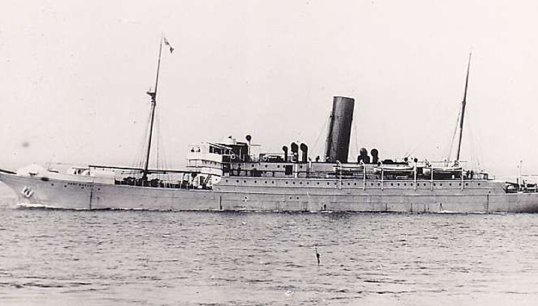Port Morant

Banana pioneer
Today, bananas are Britain's most popular fruit, with the average person eating around 100 a year. They had first appeared in British shops in small numbers the 1880s, when Elder Dempster Line began to import them from the Canary Islands, but Port Morant can lay claim to being the first dedicated 'banana boat'.
The West Indies trade was launched with British government support – an annual £40,000 subsidy – as the Colonial Office was keen not only to revive the Jamaican economy after a slump in its sugar business but also to head off growing US competition in the fruit industry.
Colonial Secretary Joseph Chamberlain entered into negotiations with Elder Dempster on the terms of a deal to carry fruit, passengers and post between Britain and the West Indies. Elder Dempster director Alfred Jones established a new company, the Imperial Direct Line, to operate what was to be a fortnightly service on the route.
The build
Built in Glasgow by Alexander Stephen & Sons, the 2,831grt Port Morant inaugurated the new service on 16 February 1901, sailing from Avonmouth with 45 passengers, 70 crew and 900 tons of cargo onboard.
Port Morant had been one of four ships ordered by a Glasgow-based firm which had been the first to secure the government's contract for the West Indies service. When that company collapsed, Elder Dempster agreed to complete the two ships on which work had begun – adding 30ft to their length to accommodate J&E Hall CO2 cargo refrigeration machinery, as well as additional passenger numbers.
Deployments
Port Morant was launched in November 1900 and completed trials in the Firth of Clyde on 6 February 1901, attaining a speed of 17 knots. Powered by a three-cylinder triple expansion engine developing 745nhp, the vessel had five refrigerated holds for carrying up to 23,000 stems of bananas.
Watched by a crowd of more than 8,000 people, Port Morant sailed from Avonmouth on 16 February 1901 and arrived in Jamaica on 1 March, loading more than 20,000 bunches of bananas and 14,000 cartons of pineapples and oranges. Back In Avonmouth on 18 March, the cargo was rapidly inspected, found to be in good condition, and packed onto trains that delivered the fruit around the country.
The success of Port Morant's voyage was quickly followed by the deployment of more ships on the route, and by the end of the decade some 200,000 bunches of bananas were being imported through Avonmouth every week.
An untimely end
The rapid expansion of the trade soon rendered Port Morant too small for the service and new tonnage, which could carry twice the amount of bananas, was ordered in 1904. The ship was transferred to the Elder Line fleet in 1905 before being sold for £52,000 to a company in Argentina in 1909. Renamed Monte Sarmiento, the vessel operated emigrant services but came to an untimely end on 2 April 1912 after running aground in the Beagle Channel while sailing from Ushuaia to Rio Gallegos.
Port Morant Fact File
When was Port Morant launched?
Port Morant was launched in 1900
What was the primary cargo of Port Morant?
The primary cargo of Port Morant was Bananas
How much was Port Morant sold for in 1909?
Port Morant was sold for £52,000
Contribute
Are you knowledgeable about this vessel?
Submit your contribution to this article to our editorial team.
Write to usView more ships of the past
HMS Beagle
Launched 200 years ago, HMS Beagle has been described as one of the most important ships in history – thanks to the observations on evolution and natural selection that its famous passenger Charles Darwin made during a five-year voyage around the world between 1831 and 1836.
Common.ReadMoreHMS Beagle
Oxfordshire
The Oxfordshire had a 34-year long career as an emigrant ship, passenger liner and cruiseship.
Common.ReadMoreOxfordshire
Ruahine
Entering into service just over 70 years ago, the Ruahine was the last passenger-carrying ship built for the New Zealand Shipping Company (NZSC), and the third to bear the name – which means 'wise woman' in Māori.
Common.ReadMore